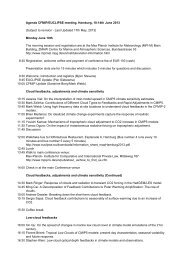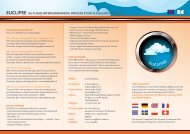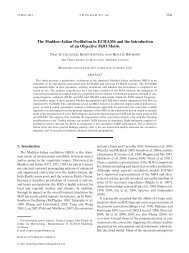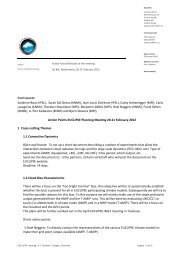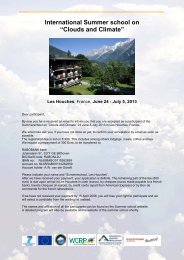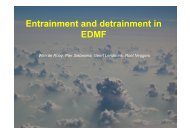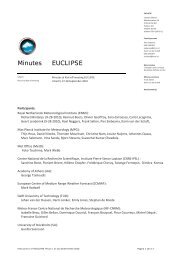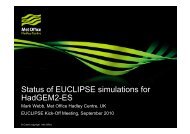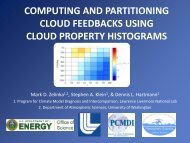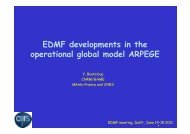EUCLIPSE First Period Report
EUCLIPSE First Period Report
EUCLIPSE First Period Report
You also want an ePaper? Increase the reach of your titles
YUMPU automatically turns print PDFs into web optimized ePapers that Google loves.
Compositing methods<br />
- Climatology of Midlatitude Storminess, allowing to composite cloud properties in the<br />
area of influence of midlatitude storms<br />
http://gcss-dime.giss.nasa.gov/mcms/mcms.html<br />
− Tropical El Niño Southern Oscillation Anomaly Database:<br />
http://gcss-dime.giss.nasa.gov/ARRA/arra.html<br />
It must be noted here that the evaluation toolkit will be continuously updated during<br />
the lifetime of the project, as corrections to the existing methods will be applied and<br />
new methods will be created.<br />
WP1.3. Planning, Organization, and Archival of ESM simulations<br />
<strong>EUCLIPSE</strong> ESMs have been performing a hierarchy of experiments, in particular those<br />
proposed by CFMIP-2 as part of the CMIP-5 coordinated experiments. The initial suite<br />
of <strong>EUCLIPSE</strong> climate experiments was performed in the context of WP1. Models are<br />
been run with atmosphere-only configurations and with prescribed Sea Surface<br />
Temperature (SST) patterns. The experiments include: a) Control AMIP simulations<br />
using interannually varying observed SSTs, b) ‘Hansen’ CO2 forcing experiments with<br />
SSTs from the control run and 4xCO2, c) SST perturbation experiments using a<br />
pattern based on a composite of CMIP3 AOGCM CO2 quadrupling experiments, d)<br />
uniform +4K SST perturbations e) Aqua-planet experiments using an idealised zonal<br />
mean climatology for the control, with 4xCO2 and uniform +4K perturbation<br />
experiments. In addition to those runs that are the focus of the CFMIP and <strong>EUCLIPSE</strong><br />
programs, WP1 participants coordinated and monitored the progress of the rest of the<br />
CMIP-5 experiments performed by the participating modelling groups.<br />
Additional diagnostics have been implemented within <strong>EUCLIPSE</strong> ESM model runs. One<br />
primary set of such diagnostics is the output from the COSP simulator. The set of<br />
simulator output variables for short periods (1-3 years) includes a lightweight set of<br />
basic simulator diagnostics, but in addition requires joint height-reflectivity<br />
distribution of CloudSat radar outputs, joint height-lidar scattering ratio distribution of<br />
lidar outputs, as well as cloud frequency of occurrence as seen by CALIPSO but not<br />
CloudSat, required for studies making combined use of CloudSat/CALIPSO simulator<br />
output.<br />
For a 1-year period of the AMIP control experiment, 3-hourly global instantaneous<br />
outputs are produced. These experiments will allow the process modelling groups in<br />
WP3 to examine the representation of cloud processes by GCMs in the current climate<br />
in any climate regime or meteorological situations without imposing a priori<br />
geographical constraints. In addition, for several years of the AMIP control run, 3hourly<br />
outputs are produced along a few transects (e.g. GCSS/WGNE-Pacific Crosssection<br />
Intercomparison - GPCI, VOCALS) or locations for which a large number of<br />
observations will be available (satellite data for GPCI, field campaign for VOCALS,<br />
long-time series of ground-based observations for ARM or CloudNet instrumented<br />
sites).<br />
WP1 has been closely monitoring the progress of both CFMIP-specific and CMIP-5 runs<br />
through regular submissions of progress reports by the different partners. As a result,<br />
13



